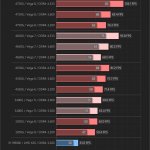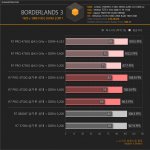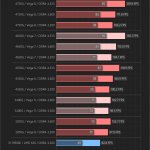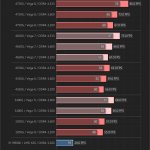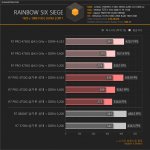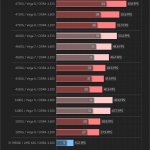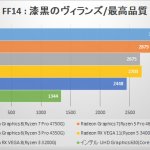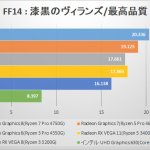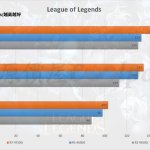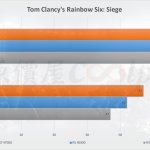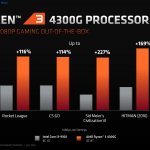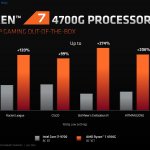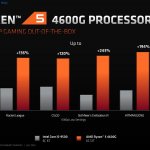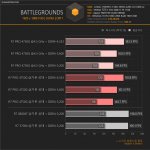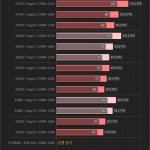AMD has officially announced its ‘Renoir’ Ryzen (PRO) 4000G series of desktop CPUs for OEMs. Featuring the 7nm Zen 2 CPU & enhanced Vega GPU architecture, the new AMD Ryzen 4000G-series of desktop processors deliver impressive generational leap in performance and amazing power efficiency for consumers, gamers, streamers and creators.
Ryzen 4000 series Desktop processors are built on the industry-leading 7nm process and ‘Zen 2’ core architecture, offering unmatched user experiences and power efficiency in the AMD socket AM4 platform. As compared to today’s Ryzen 3000G-series APUs, AMD has upgraded their processors to higher core counts from four to eight. Sadly, these processors will not be available for DIY consumers, since AMD has made a decision to first focus on pre-built OEM integrators.
AMD, however, confirmed that next gen APUs and CPUs for DIY users will be coming soon but declined to share any further details. The Ryzen 4000G APUs sport the exact same configuration as their mobile counterparts but feature additional TDP headroom that allows for higher CPU and GPU clocks. The Ryzen 4000G family is comprised of a total of six SKUs, three 65 Watts and three 35 Watts models with the flagship processor being the Ryzen 7 4700G.
Going into more details, AMD Ryzen 7 4700G/Ryzen 7 PRO 4750G are the flagship APUs of this lineup, featuring 8 cores, 16 threads, 4 MB of L2 and 8 MB of L3 cache for a total of 12 MB cache. This CPU features a base clock of 3.60 GHz and a boost clock of 4.45 GHz. The AMD Ryzen 5 4600G/Ryzen 5 PRO 4650G processors on the other hand feature 6 cores and 12 threads. These APUs have clocks configured at 3.7 GHz base and 4.2 GHz boost. They feature a 6 MB of L3 cache and have a TDP of 65W. The GPU side comes with Vega 7 integrated graphics having 448 cores running at a clock speed of up to 1900 MHz. Lastly, the AMD Ryzen 3 4300G / Ryzen 3 PRO 4350G APUs feature 4 cores and 8 threads, and have clocks configured at 3.8 GHz base and 4.0 GHz boost. They come with 4 MB of L3 cache and a TDP of 65W. The GPU side comes with Vega 6 integrated graphics that supports 384 cores running at a clock speed of up to 1700 MHz.
With their Ryzen 4000 G-series of desktop processors, AMD has claimed performance, efficiency and gaming leadership, promising performance levels exceeding today’s mainstream Intel platforms. We have some official benchmark results from both AMD and some third-party websites, which includes both the synthetic and Gaming benchmark results, but we will only focus on the Gaming part.
When compared to today’s Ryzen 5 3400G, AMD’s new Ryzen 4000G processors can deliver up to 25% more single-threaded performance, 152% more multi-threaded performance, and 19% more gaming performance.
Coming to AMD’s own internal gaming benchmarks, we can see the Ryzen 7 4700G, Ryzen 5 4600G and the AMD Ryzen 3 4300G APUs besting Intel’s 9’th-gen offerings. AMD tested the following PC games, DOTA 2, Rocket League, CS:GO, Sid Meier’s Civilization VI, Hitman (2016), and GTA 5. The Ryzen 7 4700G was tested against the Intel core i7-9700 8C/8T CPU. The Ryzen 5 4600G on the other hand was compared with the Intel core i5-9500, whereas the Ryzen 3 4300G was tested along with the Intel core i3-9100 CPU. From the graphs we can see that Sid Meier’s Civilization VI game offers a huge dramatic performance jump with the new Ryzen APUs, up to +274%, though other Games are not left far behind, with Hitman and GTA 5 also taking the lead.
The testing was done on 1080p low settings. GTA 5 is almost +243% faster with the Ryzen 5 4600G. On the Ryzen 3 4300G, Hitman game was almost +169% faster, which is an impressive feat for a 4C/8T CPU.
Coming to the third-party Gaming benchmarks, ‘quasarzone’ has tested 5 games, League of Legends, Forza Horizon 4, Battlegrounds, Rainbow Six Siege, and Overwatch. Again, we can see the new Renoir APUs offering huge performance uplift in all these games as compared to Intel’s Comet Lake offerings. Different frequency DDR4 RAM sticks were also used in the testing; 4533 Mhz, 3600 Mhz and 3200 Mhz, and once again Ryzen CPUs hugely benefit with higher clocked RAM speed Modules.
They tested these games with the RTX 2080 Ti discrete GPU, and also the integrated Vega graphics found inside these new Renoir silicon APUs. Taiwanese website ‘Coolpc’ on the other hand tested 3 games, Rainbow Six Siege, League of Legends and Assassin’s Creed: Odyssey. Though all the games were tested and compared with AMD’s own Ryzen 4000G processors, with the Ryzen 7 4700G once again taking the lead. League of Legends was also tested on three different resolutions, 1080p, 2K and 4K, respectively.
Finally, we have one Final Fantasy XIV benchmark testing done by pc-koubou on the Vega integrated Radeon graphics, on highest quality, DirectX11 and 1080p. Once again the Ryzen 7 Pro 4750G takes the performance crown when compared to the Ryzen 5 4650G, Ryzen 3 4350G, the Ryzen 5 3400G (with RX Vega 11 graphics), Ryzen 3 3200G (RX Vega 8 graphics), and finally Intel’s’ UHD 630 graphics of the Core i9-10900K CPU.
Hello, my name is NICK Richardson. I’m an avid PC and tech fan since the good old days of RIVA TNT2, and 3DFX interactive “Voodoo” gaming cards. I love playing mostly First-person shooters, and I’m a die-hard fan of this FPS genre, since the good ‘old Doom and Wolfenstein days.
MUSIC has always been my passion/roots, but I started gaming “casually” when I was young on Nvidia’s GeForce3 series of cards. I’m by no means an avid or a hardcore gamer though, but I just love stuff related to the PC, Games, and technology in general. I’ve been involved with many indie Metal bands worldwide, and have helped them promote their albums in record labels. I’m a very broad-minded down to earth guy. MUSIC is my inner expression, and soul.
Contact: Email


